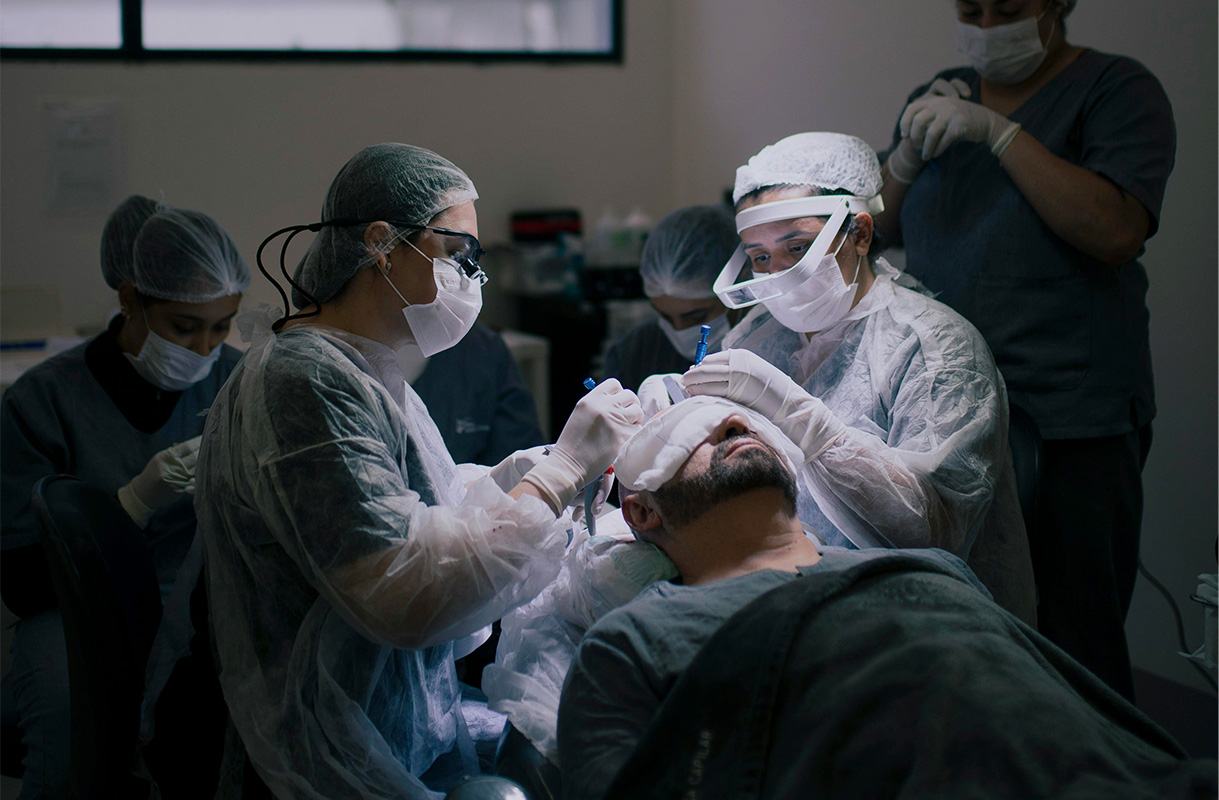Beard Hair Transplant
Beard hair transplantation is a procedure that restores hair to areas where facial hair growth is thin or missing. This surgical procedure can be performed on the goatee and mustache areas, beards, sideburns, and cheeks. Facial hair transplants are also performed to conceal acne or other facial scars.
Donor Source
When transplanting a non-scalp body area, the same area's hair is best suited if present in sufficient quantity. So, Dr. Gray prefers to harvest beard follicles when transplanting into other beard areas. While scalp follicles can also be used as the donor source, beard hair provides a healthy donor supply.
Although we are taking hair from your "beard," – the actual donor hair we use is the area "under the angle of the mandible,” or from below the jawline. If you look in the mirror and tilt your head back, the area starting below the chin is the harvested "beard hair" for transplant.
Beard Follicles vs Scalp Follicles
If you look closely, beard hair naturally, for the most part, grows as "single units" - so only single units or single follicles are transplanted into the beard area. Since the beard donor is about 99.9% single thick follicles or units, Dr. Gray can harvest and transplant these follicles as they are.
Scalp hair grows in tiny little groups of 1-4 hairs, each called "follicular units," and harvesting scalp follicular units for beard implantation requires dissecting the follicular units down to single follicles.
Each beard hair follicle also has nearly twice as many cuticle layers as hair follicles on the scalp. On average, the diameter of each beard hair is 125 microns versus scalp hair which is 69 microns. When looking at various racial groups like Caucasians, Asians, and Africans, the average beard hair diameter is 70-100% greater when compared to scalp hair for each group.
Beard hair is the most robust in growth rate, so transplanted beard hair grows well. Dr. Gray can strengthen beard areas that lack density and strengthen the edge of the beard line on the face.
How We Do It: Follicular Unit Extraction
Harvesting beard hair is different than harvesting hair from the scalp and this can be challenging for a few reasons:
- Change in angles of facial hair-bearing areas means difficulty accessing those areas. Also, hair can exit the beard in a wide variety of angles (as opposed to exiting the scalp) and finding the correct extraction angle is crucial for a successful hair transplant.
- The skin in some regions of the face is much more mobile, which makes stabilizing the skin to extract grafts more difficult.
It is imperative to use a hair transplant surgeon experienced with extracting donor hair from different sources on the body other than the scalp. Since Hair Protein Growth Factors are included in every surgery, healing time and scarring are minimized.
The Follicular Unit Extract (FUE) harvesting technique uses sharp punches and shallow insertions of up to 2mm deep to extract the follicles individually. Generally, the beard can provide thousands of single follicular donor grafts for the FUE harvesting technique, but a beard hair transplant is a smaller procedure that typically involves the placement of:
- 350 to 500 grafts for the mustache area.
- 600 to 700 grafts for a full goatee.
- 200 to 250 grafts per sideburn.
- 300 to 700 grafts for a cheek beard.
Our Follicular Unit Extraction (FUE) Procedure:
- Local anesthesia is used on the beard area to provide the patient with the most comfortable experience possible.
- Small, circular punch incisions are made around a follicular unit in the donor area.
- The single follicular units are extracted from the beard and soaked in nanoparticles (formerly called exosomes) and Protein Growth Factors.
- Tiny incisions in the beard area are made for recipient sites of the hair follicles using a fine blade.
- Individual follicular units are placed into the recipient sites in the areas of hair loss.
- Protein Growth Factors are applied to promote healing and stimulate hair growth.
- Very long-acting local anesthetic is injected for prolonged pain relief after the procedure.
Less Painful: Easier Anesthesia Application
The anesthesia for beard harvesting is relatively easy to achieve.
Dr. Gray has a technique to localize and numb the area, which blunts the burning feeling from the local anesthetic. He is very attentive to your comfort during the numbing process and the procedure.
Faster Recovery
Because all harvesting is executed below the chin and mandibular angle, no noticeable donor site is visible after the first week (as patients often shave this particular donor area), the skin is typically just a little pink.
Who Is a Candidate for Beard Transplant?
You are most likely a candidate if:
- Your beard has been “thin” in certain areas since you started shaving.
- The thin areas are symmetrical on each side of your face.
However, just because there is loss of hair in the beard does not mean every beard is a candidate. Suppose the area is an isolated patch of hair loss that has started more recently and does not have another symmetrical area of alopecia on the other side of the face. In that case, the etiology or cause of this loss may be something called alopecia barbae.
Alopecia barbae is essentially alopecia areata on the face. It is an autoimmune issue causing beard loss, and Dr. Gray does not transplant this area since the transplanted follicles may be susceptible to further autoimmune attack. Regardless, he can provide non-surgical medical treatment for alopecia barbae if you suspect you might have it.
Am I a Candidate?
If you are interested in speaking with Dr. Gray about a beard hair transplant, fill out the form below and include clear pictures of these areas:
- Area below your mandible/chin (tilt your head back and take a picture of the donor area you are interested in using)
- Area(s) on your face that you would like filled in







